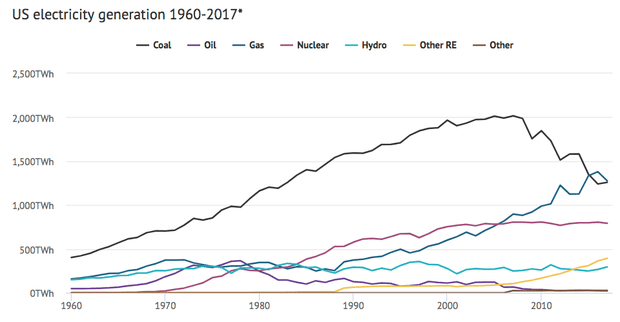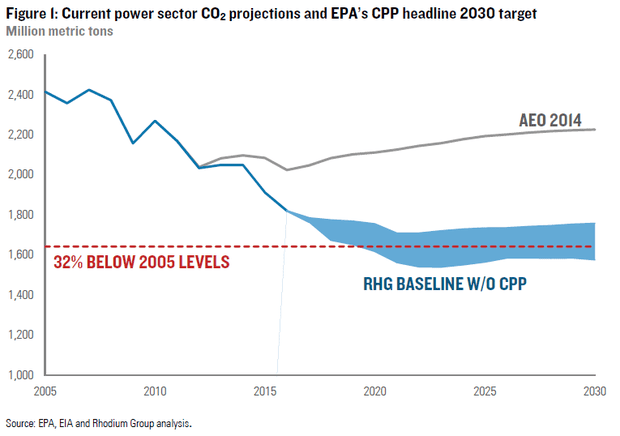
Last week, Trump’s EPA administrator Scott Pruitt announced, “the war on coal is over.” If there ever was a war on coal, the coal industry has lost. According to a new report from the Union of Concerned Scientists, many old American coal power plants are being retired or converted to natural gas, and new coal power plants aren’t being built because they’ve become more expensive than natural gas, wind, and solar energy:
The share of US electricity coming from coal fell from 51 percent in 2008 to 31 percent in 2016—an unprecedented change. New UCS analysis finds that, of the coal units that remain, roughly one in four plans to retire or convert to natural gas; another 17 percent are uneconomic and could face retirement soon.
Natural gas has now surpassed coal to supply 32% of US electricity (up from 21% in 2008), and solar and wind are up to 10% (from 3% in 2008).

Evolution of the American power grid mix since 1960. Illustration: Carbon Brief
This trend will continue. As old coal plants continue to retire and be replaced by cheaper renewables and natural gas, their share of the US electricity supply will continue to plummet, and coal will become a fossil fuel in every sense of the word. That’s why American companies continue to invest in cheap, clean renewable energy. As a result, our air and water are becoming cleaner, Americans are becoming healthier, and our carbon pollution is falling.
The shift away from coal poses a challenge for regions in which the local economy depends on the fossil fuel, but the transition is inevitable. A wise economic policy would involve funding programs to help those regions adapt to the change (Hillary Clinton proposed one such plan during her presidential campaign). A recent study showed that Americans are willing to pay a carbon tax with some of the revenue going to assist displaced coal workers. The Trump administration has instead opted to try and slow coal’s inevitable decline.
The Trump administration seems hell-bent on causing as much global warming as possible. First there was the historically irresponsible decision to withdraw from the Paris climate agreement, joining war-torn Syria as the only world countries to reject the treaty. Then just a few weeks ago, Trump’s Energy Secretary Rick Perry announced a plan to effectively take coal out of the free market and instead subsidize it with taxpayer dollars to bail out the industry and keep uneconomical coal power plants open. The hypocrisy ran thick – as Perry called for propping up the coal industry with increased taxpayer subsidies, Pruitt called for an end to subsidies for renewable energy:
I would do away with these incentives that we give to wind and solar. I’d let them stand on their own and compete against coal and natural gas and other sources, and let utilities make real-time market decisions on those types of things as opposed to being propped up by tax incentives and other types of credits that occur
Soon thereafter, Priutt announced that Trump’s EPA will repeal the Clean Power Plan. That policy represented America’s most significant effort to cut its carbon pollution, but had been mired in a legal battle over whether the plan exceeded EPA’s regulatory authority under the Clean Air Act. Rather than let the courts decide the case, which many experts felt the EPA would win, Pruitt stopped defending the case in court and ended the program.
The problem is that according to the US Supreme Court, the EPA is legally required to regulate dangerous carbon pollution. Pruitt’s EPA may propose a dramatically weakened plan that probably wouldn’t survive a court challenge, or he may just try to run out the clock on Trump’s term. As with the disastrous Republican effort to repeal the Affordable Care Act, they don’t have a replacement plan. In the meantime, states and environmental groups will take his Clean Power Plan repeal to court.
Pruitt’s Clean Power Plan repeal justification is largely based on bogus economics, which the Trump administration is using to reduce government estimates of the ‘social cost of carbon.’ This figure – which estimates how much a ton of carbon pollution costs society in terms of damages caused by climate change – is integral to many government policies. A majority of economists think the government’s estimate is too low, but Pruitt’s EPA manipulated the math by ignoring the costs of America’s carbon pollution to the rest of the world, and by using a high discount rate, which essentially says we care more about saving money now than preventing climate damages and suffering for future generations.
However, because renewables and natural gas are now cheaper than coal, an analysis by the Rhodium Group found that the US will meet the Clean Power Plan target of cutting carbon pollution from electricity generation 32% below 2005 levels by 2030 despite its repeal.

US power sector carbon dioxide emissions projections without the Clean Power Plan in place. Illustration: Rhodium Group
That being said, with the Clean Power Plan in place, the US likely would have beat its targets. As this excellent tool created by Carbon Brief shows, many states like California and Idaho are ahead of the curve, but other states like Texas and West Virginia would have been forced to accelerate their transitions to clean energy, had the Clean Power Plan been enforced.
The good news is that none of the Trump administration’s moves are permanent.
Posted by dana1981 on Monday, 16 October, 2017
 |
The Skeptical Science website by Skeptical Science is licensed under a Creative Commons Attribution 3.0 Unported License. |